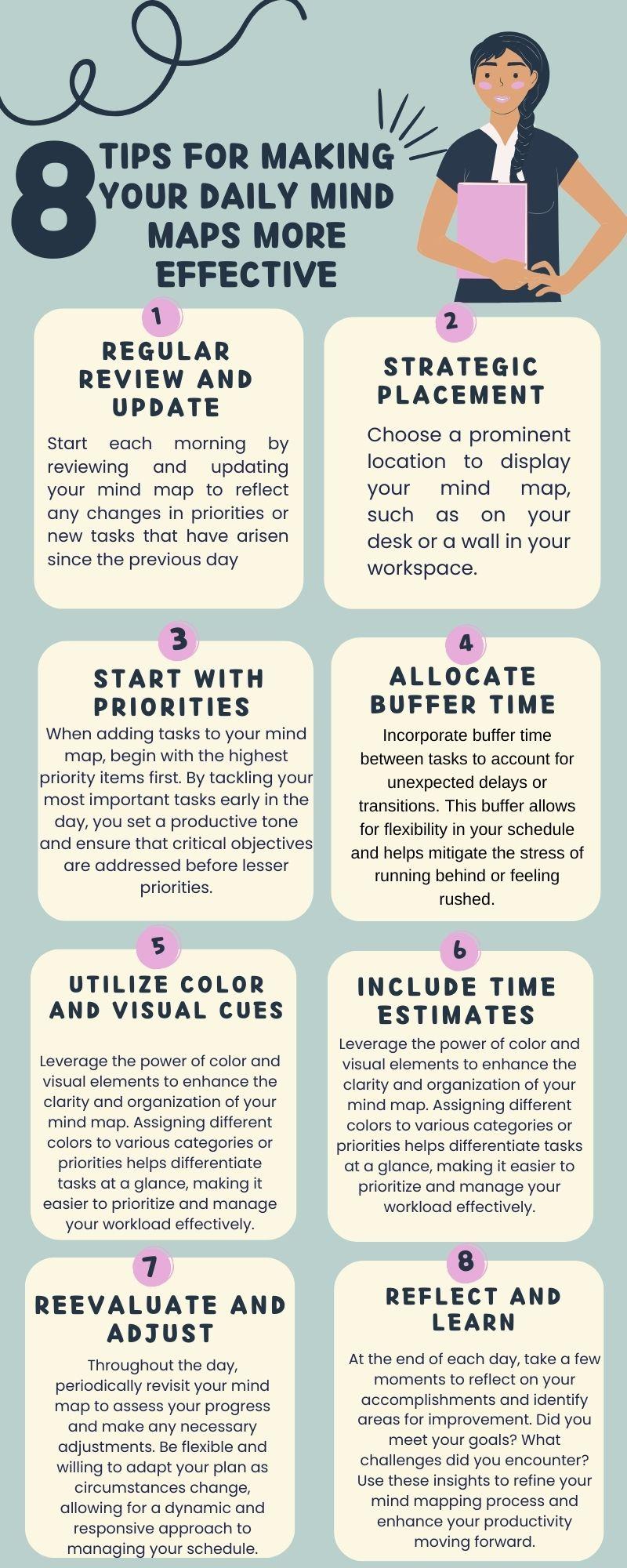Uncovering the secrets to a more organized and productive day often seems like a Herculean task in our fast-paced world. But what if there was a simple yet powerful method to transform chaos into clarity, and turn daunting to-do lists into strategic roadmaps for success? Introducing mind mapping: the innovative technique that is revolutionizing how we manage our schedules and prioritize our tasks.
As Albert Einstein once said, ‘The definition of insanity is doing the same thing over and over again, but expecting different results.’ In a world where time is our most precious commodity, it’s imperative to adopt new approaches that yield tangible results. This article serves as your guide to harnessing the transformative power of mind mapping, enabling you to unlock your full potential and seize control of your day with confidence and purpose.
From enhancing focus and productivity to cultivating creativity and streamlining prioritization, the benefits of mind mapping are boundless. Join us on this journey as we explore the art of mind mapping and equip you with the tools and techniques needed to revolutionize your daily routine. Say goodbye to chaos and hello to clarity – it’s time to mind-map your way to success!
The Benefits of Mind Mapping Your Day
Many people find mind mapping so effective for time management that they invest in specialized time management training to further enhance their skills. With some practice, anyone can leverage mind mapping to take control of their schedule.
Mind mapping allows you to see everything that needs to get done in a visual layout. This brings unique advantages over a traditional daily to-do list:
1. Improves Focus and Productivity
Mind mapping surpasses the linear nature of traditional scheduling methods by visually laying out everything that needs to be done. This visual organization not only declutters the mind but also enhances focus, enabling individuals to tackle tasks with renewed vigor and efficiency.
2. Clarity in Goal Alignment
By laying out goals and tasks in a visual framework, mind mapping clarifies the interconnectedness between various elements of our daily routines. This clarity facilitates a deeper understanding of how each task contributes to overarching goals, empowering individuals to prioritize effectively and allocate resources accordingly.
3. Encourages Creativity
The non-linear structure of mind maps fosters creative thinking and exploration of novel approaches to problem-solving. As tasks and ideas branch out from central themes, individuals are encouraged to think outside the box, leading to innovative solutions and strategies for managing their schedules.
4. Streamlined Prioritization
One of the most profound benefits of mind mapping is its ability to streamline the prioritization process. By categorizing tasks and assigning them to specific branches of the mind map, individuals can easily identify high-priority items and allocate their time and energy accordingly. This systematic approach mitigates the risk of getting bogged down by trivial tasks and ensures that focus remains on tasks that contribute most significantly to overall objectives.
5. Provides a Big Picture View
Mind mapping provides a panoramic view of daily activities, enabling individuals to grasp the entirety of their schedules at a glance. This bird’s-eye perspective empowers individuals to make informed decisions about resource allocation and time management, thereby optimizing their overall productivity and effectiveness.
How to Create a Mind Map for Your Day
Mind mapping takes some practice, but once mastered, it can quickly become second nature. Follow these steps to begin reaping the benefits:
1. Identify Your Main Goal
Start by clarifying the primary objectives or priorities you aim to accomplish within the day. Whether it’s completing work assignments, attending appointments, or pursuing personal projects, having a clear understanding of your overarching goals is essential for structuring your mind map effectively.
2. Centralize Your Goals
Once you’ve identified your main goals, designate a central focal point on your mind map to represent these objectives. This central node serves as the anchor from which all other tasks and sub-tasks will emanate, providing a cohesive framework for organizing your day.
3. Branch Out with Sub-Tasks
From each central goal, branch outwards to delineate the specific tasks and activities required to achieve it. Break down complex goals into manageable sub-tasks, ensuring that each component is clearly defined and actionable.
4. Utilize Visual Elements
Enhance the visual appeal and clarity of your mind map by incorporating colors, symbols, and images to distinguish between different categories of tasks. Visual cues not only make your mind map more engaging but also facilitate rapid comprehension and retention of information.
5. Establish Relationships
As you populate your mind map with tasks and sub-tasks, utilize connecting lines or arrows to denote relationships and dependencies between different elements. This visual representation helps you identify the logical flow of activities and prioritize tasks accordingly.
6. Allocate Time Estimates
Assign realistic time estimates to each task or sub-task to gauge the overall time required for completion. By incorporating time estimates into your mind map, you can better allocate your resources and schedule your day with precision.
7. Time Slot Allocation
Divide your day into distinct periods, such as morning, afternoon, and evening, and allocate tasks to specific time slots based on their priority and urgency. This structured approach ensures that you make efficient use of your available time and avoid overloading yourself with unrealistic expectations.
8. Regular Review and Revision
Keep your mind map dynamic and responsive to changing priorities by regularly reviewing and revising it throughout the day. As new tasks emerge or circumstances evolve, update your mind map accordingly to maintain alignment with your goals and objectives.
Tips for Making Your Daily Mind Maps More Effective
Mind maps provide the visual framework, but you’ll need to leverage some key best practices to get the most out of them:
How Mind Mapping Stacks Up to Alternatives
Mind mapping has some clear advantages over traditional scheduling tools:
| Scheduling Approach | Pros | Cons |
| Mind Mapping | Visual layout improves focus | The time investment to create maps |
| To-Do Lists | Simple and fast to make | Easy to forget tasks |
| Calendar Apps | Sync across devices | Time slots restrict flexibility |
| Bullet Journaling | Customizable and flexible | Less structured than mind maps |
The visual and customizable nature of mind mapping sets it apart from linear to-do lists or rigid calendar apps. While bullet journaling is also flexible, mind maps provide more structure.
Here are some suggested next steps:
- Try mind mapping for yourself tomorrow. Start small by just mapping out a few hours.
- Look for mind map templates online to get inspired and find what resonates.
- Check out mind mapping software like MindMeister to create digital maps.
- Set a reminder to review and update your mind map at the start of each day. Consistency matters.
The benefits of mind mapping your day are clear. Now put this innovative method into practice and unlock your best days yet. Your improved schedule and sense of control over each day await.
Conclusion
Mind mapping offers a dynamic and innovative approach to managing your schedule and maximizing productivity. By visually organizing tasks and goals, you gain clarity, focus, and control over your day, empowering you to make informed decisions and prioritize effectively. Embrace mind mapping as a continuous process of refinement and experimentation, adapting it to suit your evolving needs and preferences. With dedication and practice, you’ll experience the profound benefits of a more organized and efficient schedule, allowing you to unlock your full potential and thrive amidst life’s daily demands. Start mind mapping today and embark on a journey towards greater productivity and fulfillment.
Frequently Asked Questions About Mind Mapping
Mind mapping provides productivity and prioritization advantages, but some common questions remain:
1. I’m not very artistic, so how can I make a mind map look nice?
You don’t need to be artistic to create a useful mind map. The most important thing is that the format makes sense to you. Use words, arrows, basic shapes, and symbols to connect ideas rather than intricate drawings.
2. What if I don’t finish everything on my daily mind map? Does that mean I failed?
The mind map is a guide, not a contract. Reflect on what you accomplished rather than what you didn’t. Then optimize your map for the next day. Perfection is not the goal.
3. Can mind mapping make me more productive?
Yes, studies show mind mapping improves productivity and efficiency. The visual format optimizes your time and focus. Give it a try for a week and see if it works for you.






